Screening and Elucidation of Chemical Structures of Novel Mammalian α-Glucosidase Inhibitors Targeting Anti-Diabetes Drug from Herbals Used by E De Ethnic Tribe in Vietnam
Abstract
:1. Introduction
2. Results and Discussion
2.1. Screening and Evaluation of Medicinal Plants with Potent Inhibition of α-Glucosidase
2.2. Purification and Identification of Active Compounds from Terminalia triptera Stapf.
2.3. Evaluation of the α-Glucosidase Inhibitory Effect of Purified Compounds from Terminalia triptera Stapf.
2.4. Docking Analysis to Study the Mechanism of Interaction of Purified Compounds with the Target Enzyme, α-Glucosidase
2.5. The Lipinski’s Rule of Five and Absorption, Distribution, Metabolism, Excretion, and Toxicity (ADMET)-Based Pharmacokinetics and Pharmacology
3. Materials and Methods
3.1. Materials
3.2. General Process for Purification and Elucidation of Chemical Structures of Inhibitors Compounds
3.3. High-Performance Liquid Chromatography Analysis
3.4. Alpha-Glucosidase Inhibition Assay
- -
- Enzyme solution preparation: Enzyme solution was then sonicated 24 times, each for 12 s at 4 °C, and then centrifuged for 20 min at 10,000× g, 4 °C. The residue part was re-suspended twice with 15 mL of the same buffer (0.1 mol/L NPB, pH 7), as described above. All supernatants were mixed together and dialyzed for a half day at 4–6 °C to obtain the enzyme solution, which was then used for further analyses.
- -
- Reaction and estimation of inhibitory activity: The enzyme inhibition assay was done according to Kwon et al. 2006 [40] with slight modification. The enzyme solution (50 µL) and the sample solution (50 µL) were mixed in 150 μL of 0.1 mol/L NPB, pH 7. This mixture was pre-incubated at 37 °C for 15 min. The reaction was started by adding 50 μL of the substrate pNPG (10 mmol/L) into this mixture solution, and this duration was kept at 37 °C for 30 min, then 325 μL of 1 mol/L Na2CO3 solution were added to terminate the reaction. This absorption of the final solution was measured at 410 nm (namely, E) using a UV spectrometer (UV-2550, Shimadzu, Japan) to estimate the enzymatic activity, and the control experiment was also conducted similarly, but instead of the inhibitor solution, 50 μL 0.1 mol/L potassium phosphate buffer (pH 7) and the absorbance was measured at 410 nm (namely, C). The inhibitory effect (%) was calculated using the equation below:
3.5. Computation
3.5.1. Molecular Docking Simulation
3.5.2. The Lipinski’s Rule of Five and Absorption, Distribution, Metabolism, Excretion, and Toxicity Analysis Protocol
4. Conclusions
Author Contributions
Funding
Institutional Review Board Statement
Informed Consent Statement
Data Availability Statement
Conflicts of Interest
Appendix A
| Colour | Binding Site | Size | Residues |
|---|---|---|---|
 | 1 | 237 amino acids | ALA24 VAL25 ILE26 LEU27 GLY28 HIS29 LEU32 ARG33 ARG281 ASP282 VAL283 ALA284 TYR292 TRP376 ASP404 LEU405 ARG411 ILE441 LYS479 VAL480 TRP481 GLY483 TRP516 ASP518 MET519 ASN524 PHE525 ILE526 ARG527 ALA555 ARG600 TRP613 GLY615 ASP616 TRP618 ASP645 PHE649 GLN650 GLY651 ARG672 HIS674 ASP676 LEU677 ASN678 SER679 |
 | 2 | 27 amino acids | ARG89 PHE90 ASP91 MET122 GLY123 PRO125 PHE129 GLN247 SER249 TRP273 VAL321 GLN323 THR329 ARG331 |
 | 3 | 59 amino acids | PHE362 MET363 ARG594 PRO595 ARG608 HIS714 HIS717 VAL718 PHE859 ASP861 SER865 LEU866 GLY867 VAL868 LEU869 GLU870 |
 | 4 | 184 amino acids | ASP91 ALA93 PRO94 ASP95 LYS96 GLY97 ILE98 TRP110 ALA113 GLY114 GLN115 VAL116 LEU117 PRO120 VAL121 MET122 GLY123 GLN124 PRO125 TRP126 CYS127 HIS263 LEU264 SER265 PRO266 MET268 LEU269 SER270 GLU272 TRP273 THR274 ARG275 ILE276 THR277 GLN287 GLY288 VAL289 |
| Name of Protein | Surface Area (SA) Å2 | Volume (SA) Å3 |
|---|---|---|
| Mammalian α-glucosidase (Q6P7A9) | 4922.961 | 15,668.797 |
 | ||
| Amino acids located at the active site of Q6P7A9: MET1, ASN2, ILE3, ARG4, LYS5, PRO6, LEU21, THR22, THR23, ALA24, VAL25, ILE26, LEU27, GLY28, HIS29, LEU30, MET31, LEU32, ARG33, GLU34, LEU35, MET36, LEU37, LEU38, PRO39, GLN40, ASP41, LEU42, HIS43, GLU44, SER45, SER46, SER47, GLY48, LEU49, TRP50, LYS51, THR52, TYR53, ARG54, PRO55, HIS56, HIS57, GLU59, SER60, TYR61, PRO63, ALA64, PRO65, LEU66, HIS67, ILE68, GLN69, GLU70, HIS71, GLU73, GLN74, LEU75, ARG76, ALA77, VAL78, PRO79, CYS82, ARG89, PHE90, ASP91, ALA93, PRO94, LYS96, GLY97, ILE98, THR99, GLN100, GLU101, GLU104, CYS109, TRP110, VAL111, PRO112, ALA113, GLN115, VAL116, LEU117, ASN118, GLY119, PRO120, VAL121, MET122, GLY123, GLN124, PRO125, TRP126, CYS127, PHE129, ALA237, GLN247, SER249, GLY259, LEU260, GLY261, GLU262, HIS263, LEU264, SER265, PRO266, LEU267, MET268, LEU269, SER270, TRP273, THR274, ARG275, ILE276, THR277, ARG281, ASP282, VAL283, ALA284, PRO285, SER286, GLN287, GLY288, VAL289, ASN290, TYR292, ASP319, VAL321, GLN323, THR329, ARG331, TRP376, ASP404, LEU405, ASP409, ALA410, ARG411, ARG412, ASN417, GLN418, ASP419, ILE441, SER447, SER449, GLY450, PRO451, SER454, TYR455, LYS479, VAL480, TRP 481, PRO482, GLY483, SER484, TRP516, ASP518, MET519, SER523, ASN524, PHE525, ILE526, ARG527, TYR543, VAL544, PRO545, GLY546, VAL547, VAL548, GLY549, ALA551, ALA554, ALA555, ARG600, TRP613, GLY615, ASP616, TRP618, SER619, SER620, TRP621, GLU622, HIS623, ALA625, TYR626, PRO629, GLU630, GLN633, PHE634, LEU637, ASP645, PHE649, GLN650, GLY651, ASN652, THR653, THR654, GLU656, LEU657, ARG672, HIS674, ASP676, LEU677, ASN678, SER679, ARG742, LEU756, GLU757, PRO758, LYS760. | ||
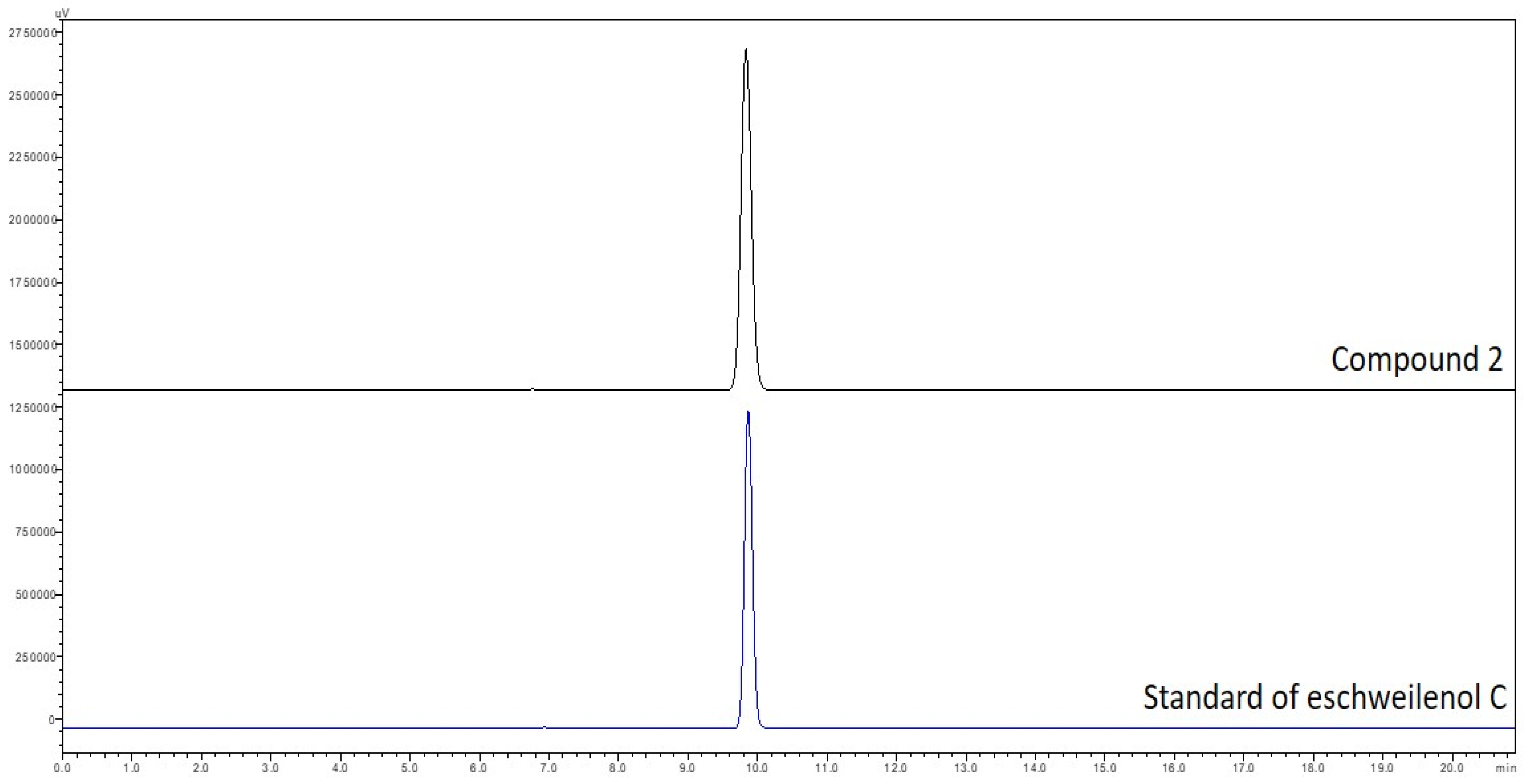
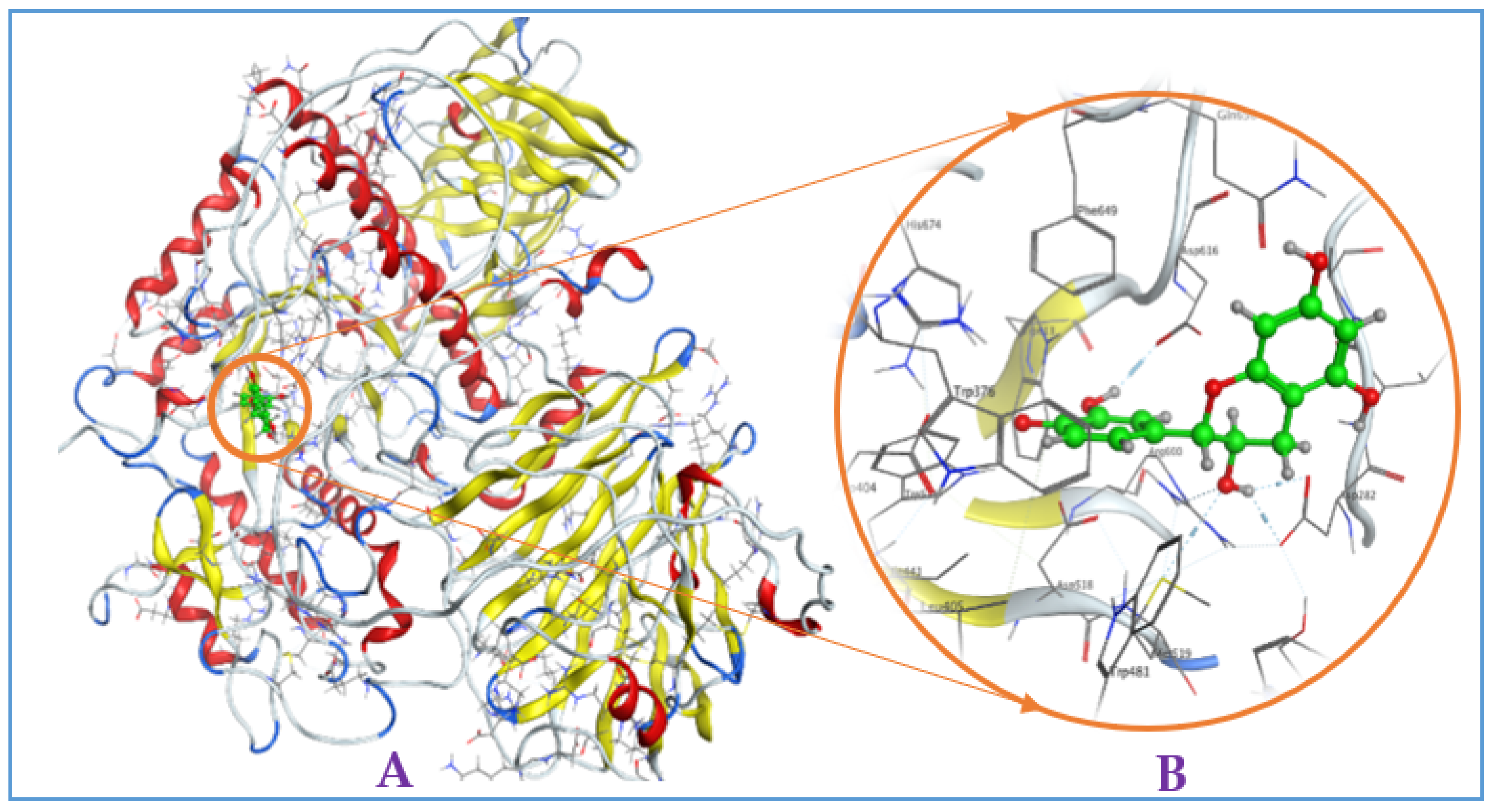
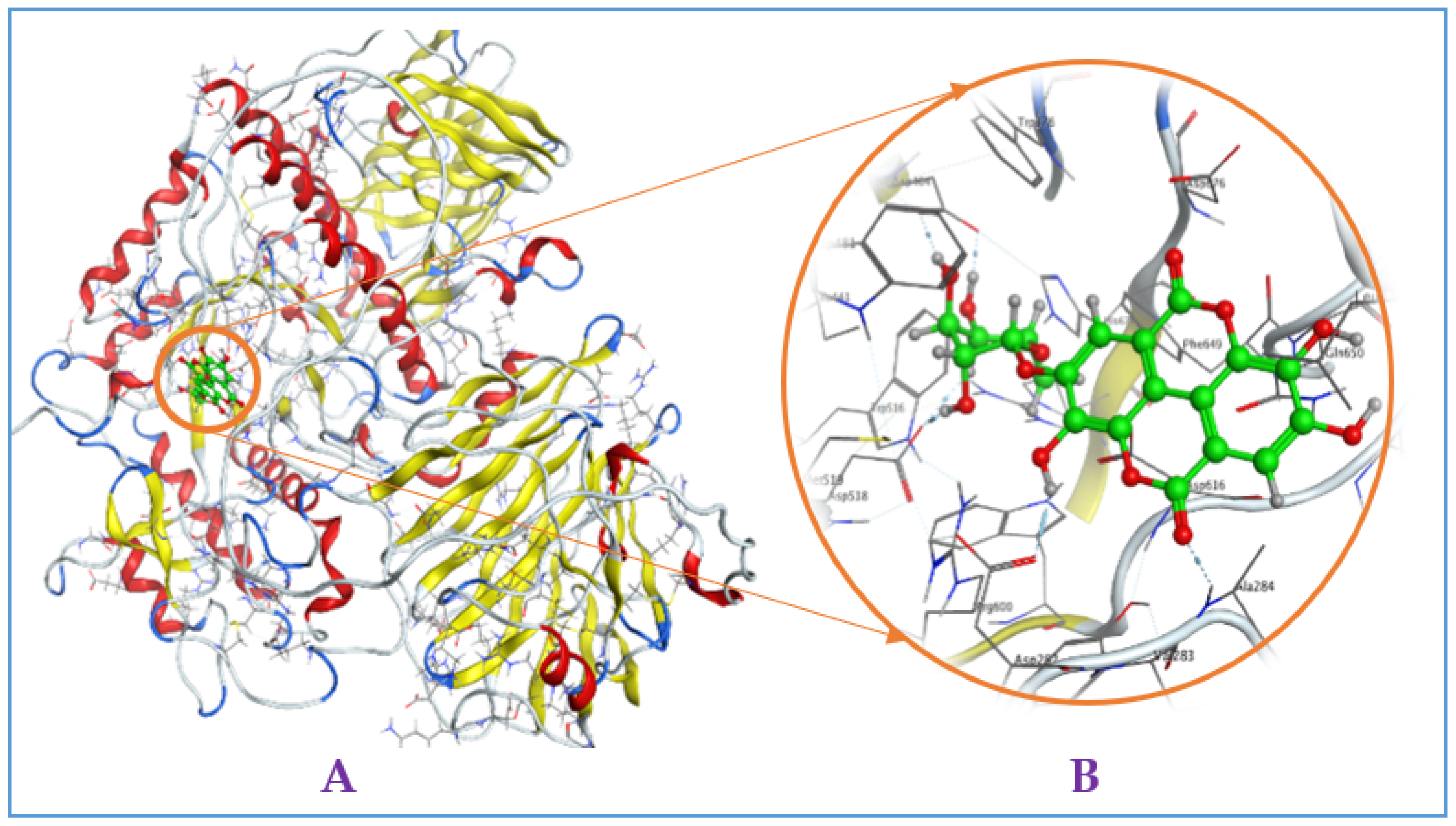
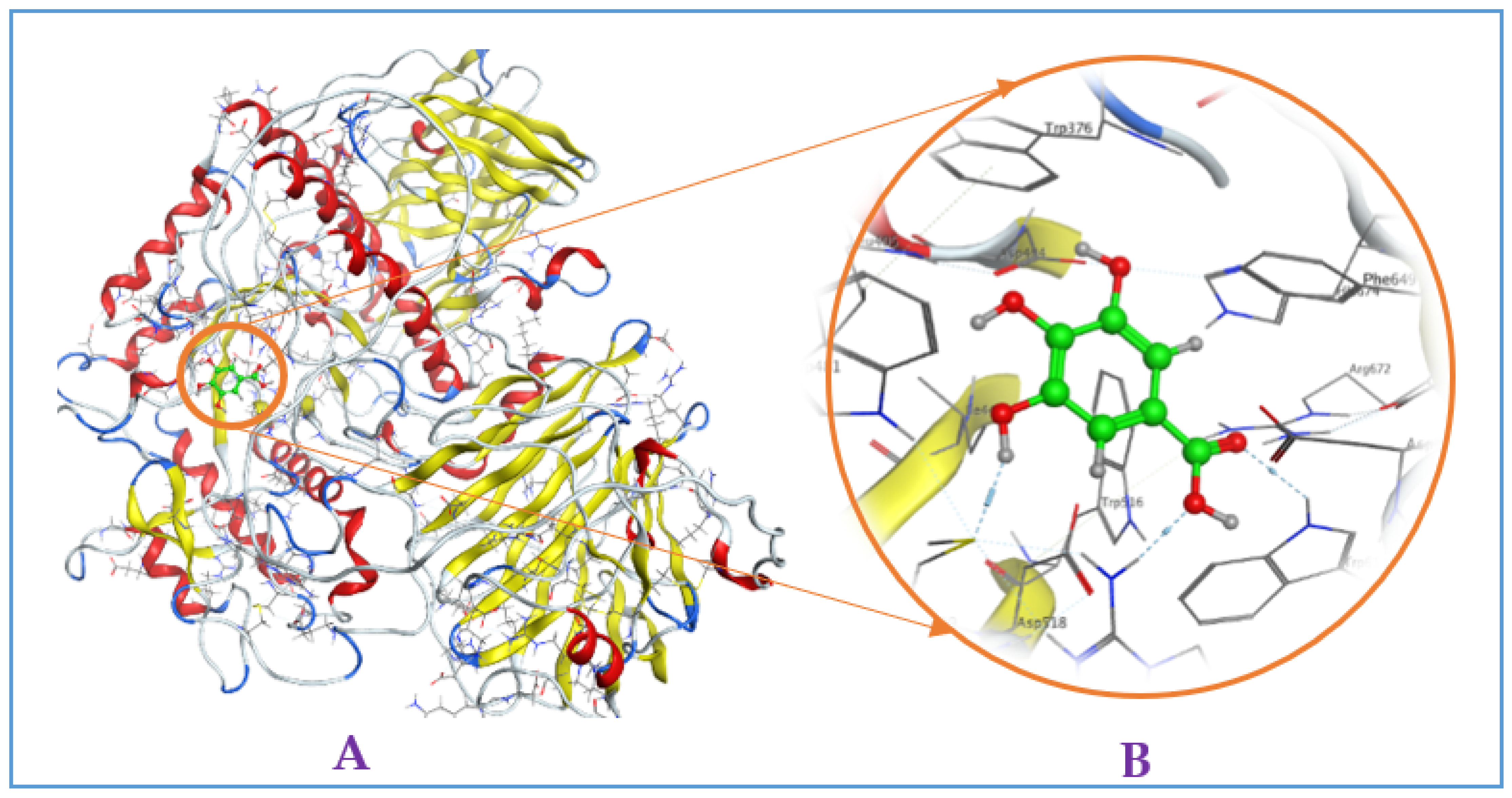

References
- Sato, K.; Nagai, N.; Yamamoto, T.; Mitamura, K.; Taga, A. Identification of a novel oligosaccharide in maple syrup as a potential alternative saccharide for diabetes mellitus patients. Int. J. Mol. Sci. 2019, 20, 5041. [Google Scholar] [CrossRef]
- DeMelo, E.B.; Gomes, A.; Carvalha, I. α-and β-Glucosidase inhibitors: Chemical structure and biological activity. J. Tetrahedr. 2006, 62, 10277–10302. [Google Scholar]
- Kashtoh, H.; Baek, K.-H. Recent updates on phytoconstituent alpha-glucosidase inhibitors: An approach towards the treatment of type two diabetes. Plants 2022, 11, 2722. [Google Scholar] [CrossRef]
- Proença, C.; Ribeiro, D.; Freitas, M.; Fernandes, E. Flavonoids as potential agents in the management of type 2 diabetes through the modulation of α-amylase and α-glucosidase activity: A review. Crit. Rev. Food Sci. Nutr. 2022, 62, 3137–3207. [Google Scholar] [CrossRef]
- Shahwan, M.; Alhumaydhi, F.; Ashraf, G.M.; Hasan, P.M.Z.; Shamsi, A. Role of polyphenols in combating type 2 diabetes and insulin resistance. Int. J. Biol. Macromol. 2022, 206, 567–579. [Google Scholar] [CrossRef]
- Shin, S.S.; Yoon, M. Regulation of obesity by antiangiogenic herbal medicines. Molecules 2020, 25, 4549. [Google Scholar] [CrossRef]
- Atanasov, A.G.; Zotchev, S.B.; Dirsch, V.M.; The International Natural Product Sciences Taskforce & Claudiu T. Supuran. Natural products in drug discovery: Advances and opportunities. Nat. Rev. Drug Discov. 2021, 20, 200–216. [Google Scholar] [CrossRef] [PubMed]
- Nguyen, V.B.; Nguyen, Q.V.; Nguyen, A.D.; Wang, S.L. Screening and evaluation of α-glucosidase inhibitors from indigenous medicinal plants in Dak Lak Province, Vietnam. Res. Chem. Intermed. 2017, 43, 3599–3612. [Google Scholar] [CrossRef]
- Gurib-Fakim, A. Medicinal plants: Traditions of yesterday and drugs of tomorrow (Electronic version). Mol. Asp. Med. 2016, 27, 1–93. [Google Scholar] [CrossRef]
- Nguyen, D.N.V.; Nguyen, T. An Overview of the Use of Plants and Animals in Traditional Medicine Systems in Viet Nam; Traffic Southeast Asia: Hanoi, Vietnam, 2008. [Google Scholar]
- Dak Lak. Available online: https://vi.wikipedia.org/wiki/%C4%90%E1%BA%AFk_L%E1%BA%AFk (accessed on 14 March 2023).
- Nguyen, V.B.; Wang, S.L.; Nhan, N.T.; Nguyen, T.H.; Nguyen, N.P.D.; Nghi, D.H.; Cuong, N.M. New records of potent in-vitro antidiabetic properties of Dalbergia tonkinensis heartwood and the bioactivity-guided isolation of active compounds. Molecules 2018, 23, 1589. [Google Scholar] [CrossRef]
- Nguyen, V.B.; Wang, S.L.; Nguyen, T.H.; Doan, C.T.; Tran, T.N.; Kuo, Y.H.; Nguyen, Q.V.; Nguyen, A.D. New indications of potential rat intestinal α-glucosidase inhibition by Syzygium zeylanicum (L.) and its hypoglycemic effect in mice. Res. Chem. Intermed. 2019, 45, 6061–6071. [Google Scholar] [CrossRef]
- Nguyen, N.C.; Hoang, T.S.; Lin, C.W.; Nguyen, V.K. Begonia kimlongii (B. sect. Petermannia, Begoniaceae), a new species from Dak Lak, Central Highlands, Vietnam. Phytotaxa 2022, 547, 193–200. [Google Scholar] [CrossRef]
- Nguyen, Q.V.; Nguyen, V.B.; Eun, J.B.; Wang, S.L.; Nguyen, D.H.; Tran, T.N.; Nguyen, A.D. Anti-oxidant and antidiabetic effect of some medicinal plants belong to Terminalia species collected in Dak Lak Province, Vietnam. Res. Chem. Intermed. 2016, 42, 5859–5871. [Google Scholar] [CrossRef]
- Lei, W.; Yunliang, L.; Ruimin, L.; Huijiao, Y.; Jinqian, Y.; Hengqiang, Z.; Xiao, W.; Daijie, W. An efficient method for the preparative isolation and purification of flavonoids from leaves of Crataegus pinnatifida by HSCCC and pre-HPLC. Molecules 2017, 22, 767. [Google Scholar]
- Alyne, R.A.; Bruno, I.; Kerolayne, M.N.; Jhones, N.D.; Alexandra, P.; Artur, R.; Patrícia, A.; Ildinete, S.P.; Renato, S.; Camila, C.P.; et al. Antifungal and anti-inflammatory potential of eschweilenol C-rich fraction derived from Terminalia fagifolia mart. J Ethnopharmacol. 2019, 240, 111941. [Google Scholar]
- Khem, R.J.; Hari, P.D.; Takashi, W.; Shoji, Y. Pohenolic cmpounds from the flowers of Nepalese medicinal plant Aconogonon molle and their DPPH free radical-scavenging activities. Nat. Prod. Res. 2014, 28, 2208–2210. [Google Scholar]
- Das, G.; Kim, D.Y.; Fan, C.; Gutie’rrez, G.E.P.; Heredia, J.B.; Nissapatorn, V.; Mitsuwan, W.; Pereira, M.L.; Nawaz, M.; Siyadatpanah, A.; et al. Plants of the genus Terminalia: An insight on its biological potentials, pre-clinical and clinical studies. Front. Pharmacol. 2020, 11, 561248. [Google Scholar] [CrossRef]
- Pettit, G.R.; Hoard, M.S.; Doubek, D.L.; Schmidt, J.M.; Pettit, R.K.; Tackett, L.P.; Chapuis, J.C. Antineoplastic agents 338. The cancer cell growth inhibitory. constituents of Terminalia arjuna (Combretaceae). J. Ethnopharmacol. 1996, 53, 57–63. [Google Scholar] [CrossRef] [PubMed]
- Pham, A.T.; Malterud, K.E.; Paulsen, B.S.; Diallo, D.; Wangensteen, H. Alpha-glucosidase inhibition, 15-lipoxygenase inhibition, and brine shrimp toxicity of extracts and isolated compounds from Terminalia macroptera leaves. Pharm. Biol. 2014, 52, 1166–1169. [Google Scholar] [CrossRef]
- Salih, E.Y.A.; Julkunen, T.R.; Lampi, A.M.; Kanninen, M.; Luukkanen, O.; Sipi, M.; Lehtonen, M.; Vuorela, H.; Fyhrquist, P. Terminalia laxiflora and Terminalia brownii contain a broad spectrum of antimycobacterial compounds including ellagitannins, ellagic acid derivatives, triterpenes, fatty acids and fatty alcohols. J. Ethnopharmacol. 2018, 227, 82–96. [Google Scholar] [CrossRef]
- Dai, J.; Mumper, R.J. Plant Phenolics: Extraction, analysis and their antioxidant and anticancer properties. Molecules 2010, 15, 7313–7352. [Google Scholar] [CrossRef]
- Tungmunnithum, D.; Thongboonyou, A.; Pholboon, A.; Yangsabai, A. Flavonoids and other phenolic compounds from medicinal plants for pharmaceutical and medical aspects: An overview. Medicines 2018, 5, 93. [Google Scholar] [CrossRef] [PubMed]
- Sun, W.; Shahrajabian, M.H. Therapeutic potential of phenolic compounds in medicinal plants—Natural health products for human health. Molecules 2023, 28, 1845. [Google Scholar] [CrossRef] [PubMed]
- Raudone, L.; Radušiene, J.; Seyis, F.; Yayla, F.; Vilkickyte, G.; Marksa, M.; Ivanauskas, L.; Cırak, C. Distribution of phenolic compounds and antioxidant activity in plant parts and populations of seven underutilized wild Achillea species. Plants 2022, 11, 447. [Google Scholar] [CrossRef]
- Nguyen, V.B.; Wang, S.L.; Nguyen, A.D.; Vo, T.P.K.; Zhang, L.J.; Nguyen, Q.V.; Kuo, Y.H. Isolation and identification of novel α-amylase inhibitors from Euonymus laxiflorus Champ. Res. Chem. Intermed. 2018, 44, 1411–1424. [Google Scholar] [CrossRef]
- Rasouli, H.; Farzaei, M.H.; Khodarahmi, R. Polyphenols and their benefits: A review. Int. J. Food Prop. 2017, 20, 1700–1741. [Google Scholar] [CrossRef]
- Yin, Z.; Zhang, W.; Feng, F.; Zhang, Y.; Kang, W. α-Glucosidase inhibitors isolated from medicinal plants. Food Sci. Hum. Wellness 2014, 3, 136–174. [Google Scholar] [CrossRef]
- Mamadalieva, N.Z.; Hussain, H.; Mollica, A.; Zengin, G.; Mamadalieva, R.Z.; Elhady, S.S.; Fadil, S.A.; Ashour, M.L.; Youssef, F.S. Ecdysteroids as potent enzyme inhibitors and verification of their activity using in vitro and in silico docking studies. Life 2022, 12, 824. [Google Scholar] [CrossRef]
- Mujawah, A.; Rauf, A.; Bawazeer, S.; Wadood, A.; Hemeg, H.A.; Bawazeer, S. Isolation, structural elucidation, in vitro anti-α-glucosidase, anti-β-secretase, and in silico studies of bioactive compound isolated from Syzygium cumini L. Processes 2023, 11, 880. [Google Scholar] [CrossRef]
- Khan, B.A.; Hamdani, S.S.; Khalid, M.; Ashfaq, M.; Munawar, K.S.; Tahir, M.N.; Braga, A.A.C.; Shawky, A.M.; Alqahtani, A.M.; Abourehab, M.A.S.; et al. Exploring probenecid derived 1,3,4-Oxadiazole-phthalimide hybrid as α-amylase inhibitor: Synthesis, structural investigation, and molecular modeling. Pharmaceuticals 2023, 16, 424. [Google Scholar] [CrossRef] [PubMed]
- Khan, B.A.; Hamdani, S.S.; Jalil, S.; Ejaz, S.A.; Iqbal, J.; Shawky, A.M.; Alqahtani, A.M.; Gabr, G.A.; Ibrahim, M.A.A.; Sidhom, P.A. Synthesis and evaluation of novel S-alkyl phthalimide- and S-benzyl-oxadiazole-quinoline hybrids as inhibitors of monoamine oxidase and acetylcholinesterase. Pharmaceuticals 2023, 16, 11. [Google Scholar] [CrossRef]
- Tayier, N.; Qin, N.-Y.; Zhao, L.-N.; Zeng, Y.; Wang, Y.; Hu, G.; Wang, Y.-Q. Theoretical exploring of a molecular mechanism for melanin inhibitory activity of calycosin in zebrafish. Molecules 2021, 26, 6998. [Google Scholar] [CrossRef]
- Gupta, N.; Choudhary, S.K.; Bhagat, N.; Karthikeyan, M.; Chaturvedi, A. In Silico Prediction, Molecular Docking and Dynamics Studies of Steroidal Alkaloids of Holarrhena pubescens Wall. ex G. Don to Guanylyl Cyclase C: Implications in Designing of Novel Antidiarrheal Therapeutic Strategies. Molecules 2021, 26, 4147. [Google Scholar] [CrossRef] [PubMed]
- Ding, Y.; Fang, Y.; Moreno, J.; Ramanujam, J.; Jarrell, M.; Brylinski, M. Assessing the similarity of ligand binding conformations with the contact mode score. Comput. Biol. Chem. 2016, 64, 403–413. [Google Scholar] [CrossRef]
- Chandra, B.T.M.; Rajesh, S.S.; Bhaskar, B.V.; Devi, S.; Rammohan, A.; Sivaraman, T.; Rajendra, W. Molecular docking, molecular dynamics simulation, biological evaluation and 2D QSAR analysis of flavonoids from Syzygium alternifolium as potent anti-Helicobacter pylori agents. RSC Adv. 2017, 7, 18277–18292. [Google Scholar] [CrossRef]
- Kim, Y.; Wang, M.; Rhee, M.J. A novel alpha-glucosidase inhibitor from pine bark. Carbohydr. Res. 2004, 339, 715–717. [Google Scholar] [CrossRef]
- Lipinski, C.A.; Lombardo, F.; Dominy, B.W.; Feeney, P.J. Experimental and computational approaches to estimate solubility and permeability in drug discovery and development settings. Adv. Drug Deliv. Rev. 2001, 46, 3–26. [Google Scholar] [CrossRef] [PubMed]
- Won, Y.I.; Jang, H.D.; Shetty, K. Evaluation of Rhodiola crenulata and Rhodiola rosea for management of type II diabetes and hypertension. Asia Pac. J. Clin. Nutr. 2006, 15, 425–432. [Google Scholar]
- Mamadalieva, N.Z.; Youssef, F.S.; Hussain, H.; Zengin, G.; Mollica, A.; Al Musayeib, N.M.; Ashour, M.L.; Westermann, B.; Wessjohann, L.A. Validation of the antioxidant and enzyme inhibitory potential of selected triterpenes using in vitro and in silico studies, and the evaluation of their ADMET properties. Molecules 2021, 26, 6331. [Google Scholar] [CrossRef]
- Mollica, A.; Zengin, G.; Durdagi, S.; Ekhteiari Salmas, R.; Macedonio, G.; Stefanucci, A.; Dimmito, M.P.; Novellino, E. Combinatorial peptide library screening for discovery of diverse α-glucosidase inhibitors using molecular dynamics simulations and binary QSAR models. J. Biomol. Str. Dynam. 2019, 37, 726–740. [Google Scholar] [CrossRef]
- Li, H.; He, Z.; Shen, Q.; Fan, W.; Tan, G.; Zou, Y.; Mei, Q.; Qian, Z. Rapid screening alpha-glucosidase inhibitors from polygoni vivipari rhizoma by multi-step matrix solid-phase dispersion, ultrafiltration and HPLC. Molecules 2021, 26, 6111. [Google Scholar] [CrossRef] [PubMed]
- Edwin, E.-S.; Vasantha-Srinivasan, P.; Senthil-Nathan, S.; Chellappandian, M.; Karthi, S.; Narayanaswamy, R.; Stanley-Raja, V.; Sivanesh, H.; Ramasubramanian, R.; Al-Huqail, A.A.; et al. Toxicity of bioactive molecule andrographolide against Spodoptera litura Fab and its binding potential with detoxifying enzyme cytochrome P450. Molecules 2021, 26, 5982. [Google Scholar] [CrossRef] [PubMed]
- Zhao, C.-P.; Chen, G.-Y.; Wang, Y.; Chen, H.; Yu, J.-W.; Yang, F.-Q. Evaluation of enzyme inhibitory activity of flavonoids by polydopamine-modified hollow fiber-immobilized xanthine oxidase. Molecules 2021, 26, 3931. [Google Scholar] [CrossRef] [PubMed]
- Pires, D.E.; Blundell, T.L.; Ascher, D.B. PkCSM: Predicting smallmolecule pharmacokinetic and toxicity properties using graphbased signatures. J. Med. Chem. 2015, 58, 4066–4072. [Google Scholar] [CrossRef]
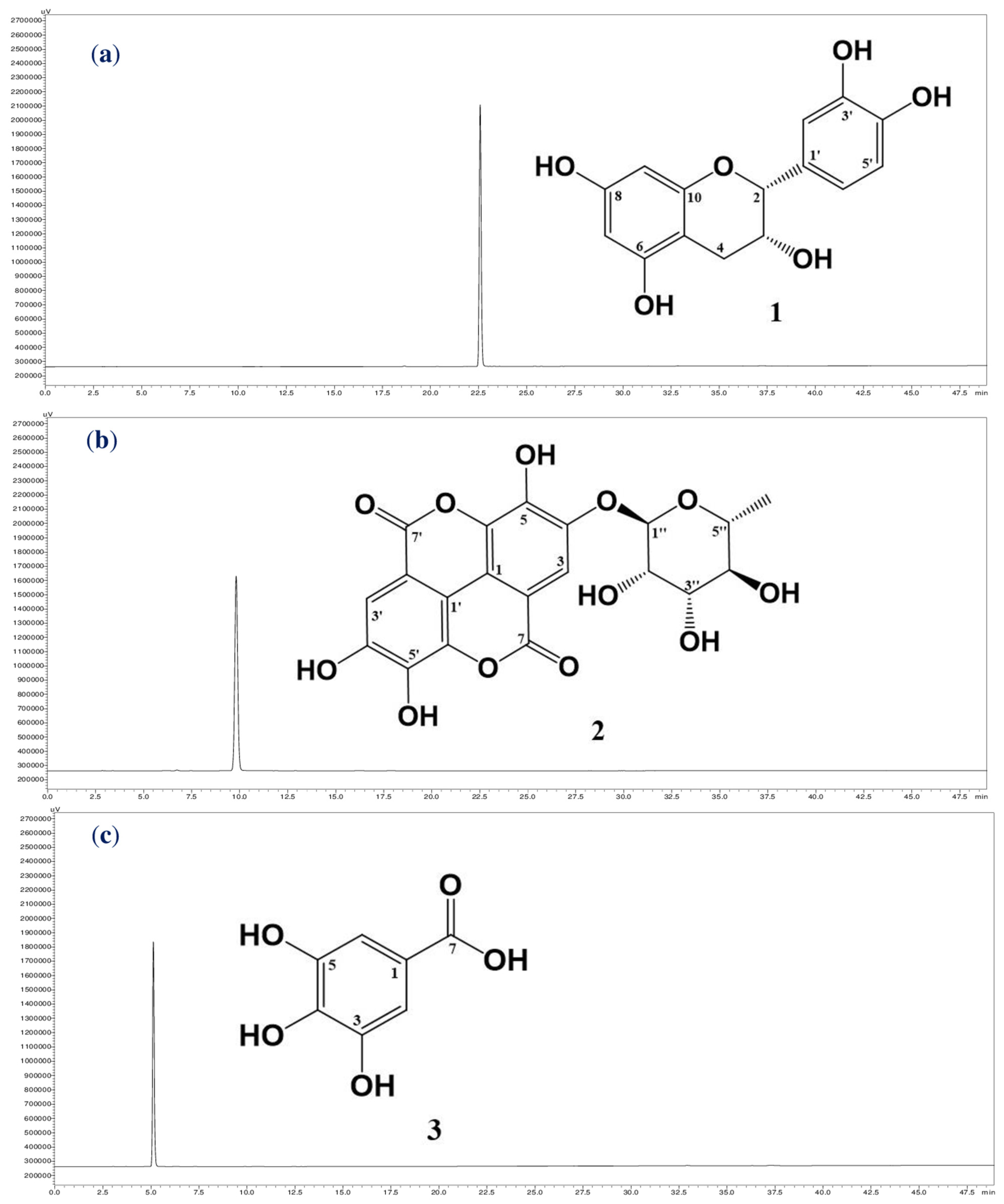
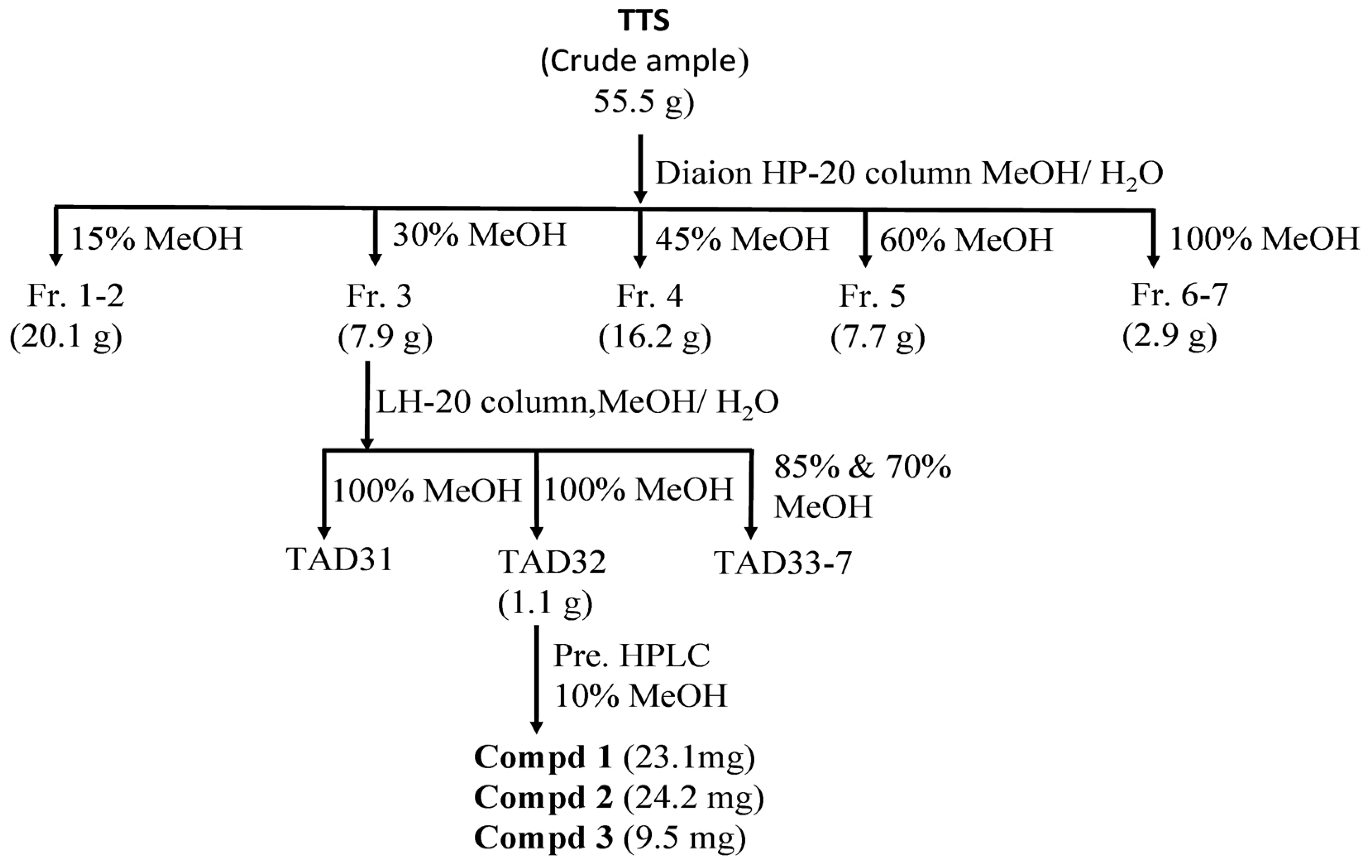
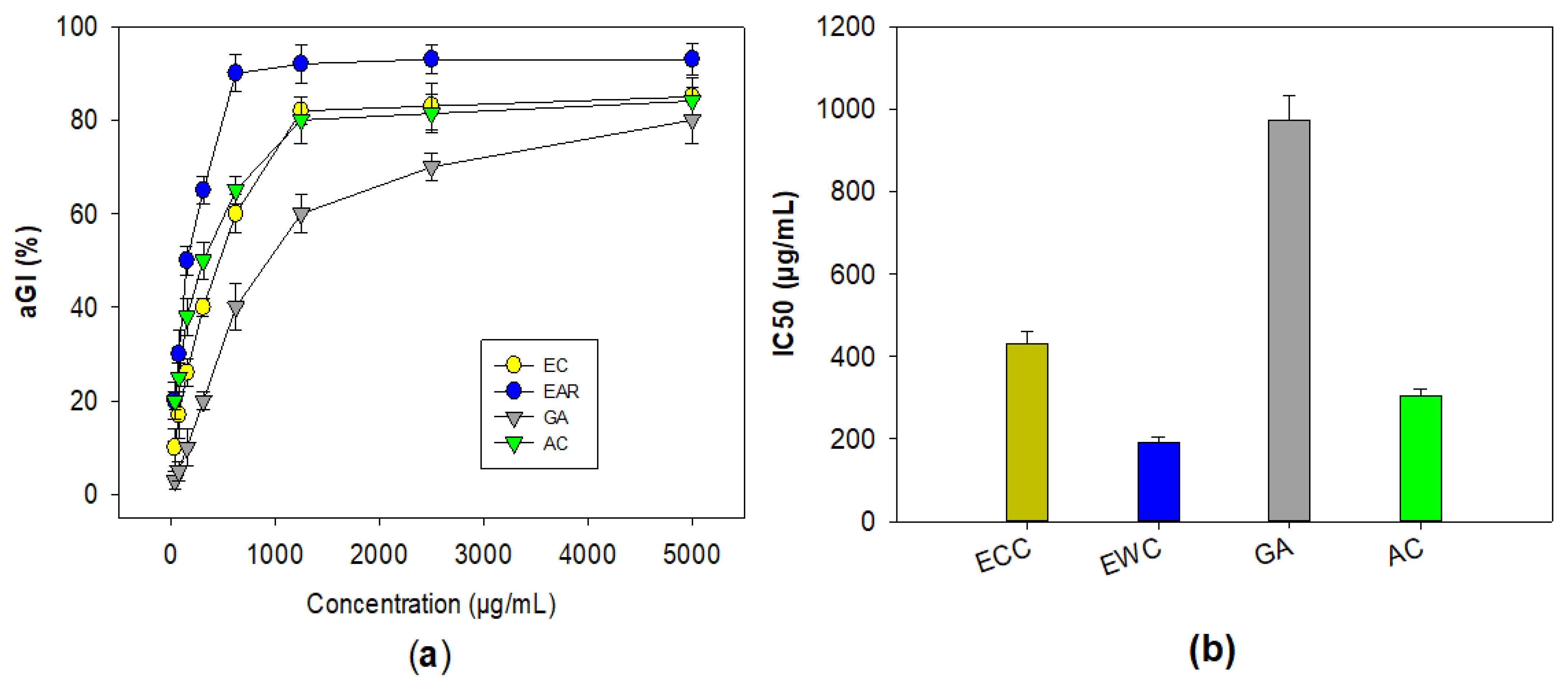
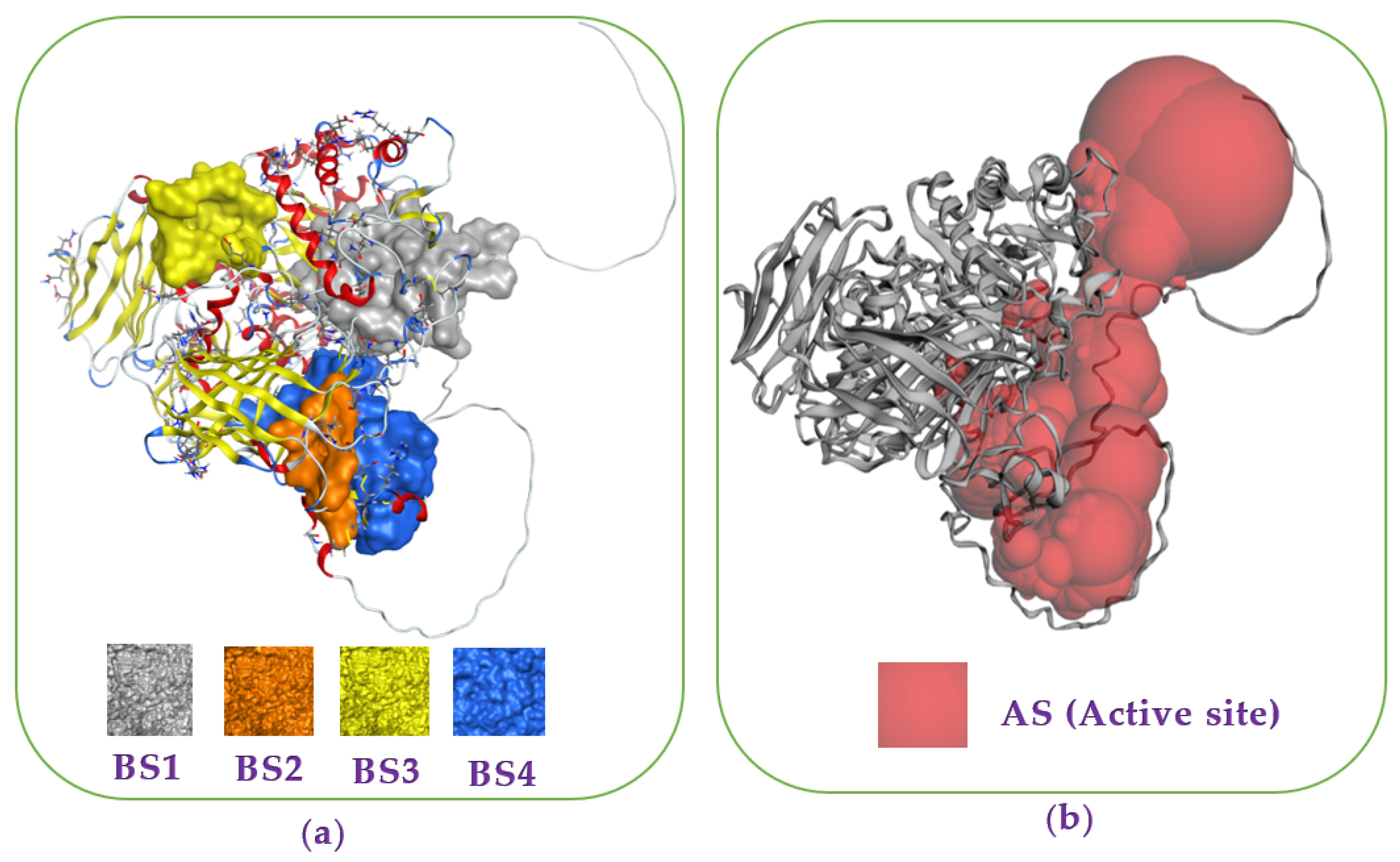

| No. | Scientific Name of Medicinal Plants (And Namely by E De Ethnic Tribe) | Codes | Parts Used | Inhibition of Rat α-Glucosidase | |
|---|---|---|---|---|---|
| % | IC50 (µg/mL) | ||||
| 1 | Lagerstroemia calyculata Kurz. (Ana tluôl) | LCK | Trunk bark | 30.06 | ≥12,667 |
| 2 | Vernonia cinerea (L.) Less. (Hbâo bơong) | VCL | Whole plant | ≥5683 | |
| 3 | Antidesma bunius (L.) Spreng. (Mong muôch) | ABS | Trunk | 12.06 | ≥5650 |
| 4 | Leea rubra Blume (Ana bho jâo mdiê) | LRB | Whole plant | 41.05 | ≥6117 |
| 5 | Cratoxylon formosum (Jack) Dyer ssp. pruniflorum (Kurz.) Gog. (Ana êngiêng) | CFDG | Trunk bark | 97.2 | 3356 |
| 6 | Terminalia triptera Stapf. (Ana đrik) | TTS | Trunk bark | 99.51 | 178.8 |
| Leaves | 94.2 | 331 | |||
| Heartwood | 48.4 | ≥1000 | |||
| 7 | Dalbergia nigrescens Kurz var. anomala (Pierre) Niyomdham (Ana mkul) | DNKN | Trunk bark | 39.36 | ≥3716 |
| 8 | Combretum quadrangulare Kurz. (Ana ktit dir) | CQK | Trunk bark | 18.72 | ≥6083 |
| 9 | Vitex pinnata L. var. Ptilota (P.Dop.) (Ana plăi) | VLVP | Trunk bark | 37.74 | ≥4450 |
| 10 | Solanum torvum Swartz (Trong lao) | STS | Trunk bark | 18.38 | ≥9700 |
| Acarbose (commercial inhibitor) | 92 | 310 | |||
| No. | Ligands | Symbol of L-P Complex | RMSD (Å) | DS (kcal/mol) | Linkages | Amino Acids Interacting with the Ligands [Distance (Å)/E (kcal/mol)/ Linkage Type] |
|---|---|---|---|---|---|---|
| 1. | (−)-epicatechin | ECC-Q6P7A9 | 1.56 | −11.4 | 5 linkages (4 H-donor, 1 H-acceptor) | ASP282 (3.31/−0.9/H-donor) ASP282 (2.99/−1.9/H-donor) MET519 (3.43/−1.5/H-donor) ASP616 (2.86/−4.4/H-donor) ARG600 (3.34/−0.4/H-acceptor) |
| 2. | Eschweilenol C | EWC-Q6P7A9 | 1.16 | −12.8 | 6 linkages (5 H-donor, 1 H-acceptor) | ASP282 (2.80/−5.8/H-donor) ASP518 (3.13/−1.5/H-donor) ASP404 (3.36/−1.4/H-donor) ASP404 (2.65/−0.7/H-donor) ASP518 (2.71/−2.7/H-donor) ALA284 (3.09/−1.1/H-acceptor) |
| 3. | Gallic acid | GA-Q6P7A9 | 0.77 | −10.1 | 3 linkages (1 H-donor, 2 H-acceptor) | MET519 (3.14/−2.9/H-donor) ARG600 (3.05/−1.4/H-acceptor) TRP613 (3.26/−1.0/H-acceptor) |
| 4. | Acarbose | AC-Q6P7A9 | 0.94 | −11.4 | 5 linkages (2 H-donor, 3 H-acceptor) | ASP91 (2.94/−2.1/H-donor) GLY119 (3.35/−0.6/H-donor) TRP126 (3.35/−1.1 H-acceptor) ARG275 (2.93/−2.8 H-acceptor) CYS127 (3.36/−0.6 H-acceptor) |
| Compound | Mass (Dalton) | Hydrogen Bond Donor | Hydrogen Bond Acceptors | LogP | Molar Refractivity |
|---|---|---|---|---|---|
| ECC | 290.00 | 5 | 6 | 1.546 | 72.62 |
| EWC | 448.00 | 6 | 12 | −1.898 | 95.17 |
| GA | 170.00 | 3 | 5 | −0.833 | 35.766899 |
| AC | 646.00 | 15 | 19 | −9.591 | 136.52 |
| Lipkin’s rules | ≤500 | ≤5 | ≤10 | ≤5 | 40–130 |
| Property | ECC | EWC | GA | AC | Unit |
|---|---|---|---|---|---|
| Absorption | |||||
| Water solubility | −3.196 | −2.946 | −1.355 | −1.482 | log mol/L−1 |
| Caco2 permeability | −0.402 | 0.622 | −0.023 | −0.481 | log Papp (10−6 cm/s−1) |
| Intestinal absorption (human) | 72.619 | 53.062 | 40.154 | 4.172 | % |
| Skin permeability | −2.735 | −2.735 | −2.755 | −2.735 | log Kp |
| P-glycoprotein substrate | Yes | Yes | No | Yes | Yes/No |
| P-glycoprotein I inhibitor | No | No | No | No | Yes/No |
| P-glycoprotein II inhibitor | No | No | No | No | Yes/No |
| Distribution | |||||
| VDss (human) | 0.215 | 0.53 | −0.421 | −0.836 | log L/kg−1 |
| Fraction unbound (human) | 0.139 | 0.131 | 0.413 | 0.505 | log L/kg−1 |
| BBB permeability | −1.069 | −1.519 | −1.111 | −1.717 | log BB |
| CNS permeability | −3.403 | −4.501 | −4.157 | −6.438 | log PS |
| Metabolism | |||||
| CYP2D6 substrate | No | No | No | No | Yes/No |
| CYP3A4 substrate | No | No | No | No | Yes/No |
| CYP1A2 inhibitor | No | No | No | No | Yes/No |
| CYP2C19 inhibitor | No | No | No | No | Yes/No |
| CYP2C9 inhibitor | No | No | No | No | Yes/No |
| CYP2D6 inhibitor | No | No | No | No | Yes/No |
| CYP3A4 inhibitor | No | No | No | No | Yes/No |
| Excretion | |||||
| Total clearance | 0.29 | 0.561 | 0.625 | 0.428 | log mL/min−1/kg−1 |
| Renal OCT2 substrate | No | No | No | No | Yes/No |
| Toxicity | |||||
| AMES toxicity | Yes | No | No | No | Yes/No |
| Max. tolerated dose (human) | 0.448 | 0.561 | 0.611 | 0.435 | log mg/kg−1/day−1 |
| hERG I inhibitor | No | No | No | No | Yes/No |
| hERG II inhibitor | No | No | No | Yes | Yes/No |
| Oral Rat Acute Toxicity (LD50) | 2.129 | 2.499 | 1.911 | 2.449 | mol/kg−1 |
| Oral Rat Chronic Toxicity (LOAEL) | 2.032 | 4.035 | 2.865 | 5.319 | log mg/kg−1_bw/day−1 |
| Hepatotoxicity | No | No | No | No | Yes/No |
| Skin Sensitisation | No | No | No | No | Yes/No |
| T. Pyriformis toxicity | 0.345 | 0.285 | 0.087 | 0.285 | log μg/L−1 |
| Minnow toxicity | 1.926 | 2.529 | 2.187 | 16.823 | log mM |
Disclaimer/Publisher’s Note: The statements, opinions and data contained in all publications are solely those of the individual author(s) and contributor(s) and not of MDPI and/or the editor(s). MDPI and/or the editor(s) disclaim responsibility for any injury to people or property resulting from any ideas, methods, instructions or products referred to in the content. |
© 2023 by the authors. Licensee MDPI, Basel, Switzerland. This article is an open access article distributed under the terms and conditions of the Creative Commons Attribution (CC BY) license (https://creativecommons.org/licenses/by/4.0/).
Share and Cite
Nguyen, V.B.; Wang, S.-L.; Phan, T.Q.; Pham, T.H.T.; Huang, H.-T.; Liaw, C.-C.; Nguyen, A.D. Screening and Elucidation of Chemical Structures of Novel Mammalian α-Glucosidase Inhibitors Targeting Anti-Diabetes Drug from Herbals Used by E De Ethnic Tribe in Vietnam. Pharmaceuticals 2023, 16, 756. https://doi.org/10.3390/ph16050756
Nguyen VB, Wang S-L, Phan TQ, Pham THT, Huang H-T, Liaw C-C, Nguyen AD. Screening and Elucidation of Chemical Structures of Novel Mammalian α-Glucosidase Inhibitors Targeting Anti-Diabetes Drug from Herbals Used by E De Ethnic Tribe in Vietnam. Pharmaceuticals. 2023; 16(5):756. https://doi.org/10.3390/ph16050756
Chicago/Turabian StyleNguyen, Van Bon, San-Lang Wang, Tu Quy Phan, Thi Huyen Thoa Pham, Hung-Tse Huang, Chia-Ching Liaw, and Anh Dzung Nguyen. 2023. "Screening and Elucidation of Chemical Structures of Novel Mammalian α-Glucosidase Inhibitors Targeting Anti-Diabetes Drug from Herbals Used by E De Ethnic Tribe in Vietnam" Pharmaceuticals 16, no. 5: 756. https://doi.org/10.3390/ph16050756
APA StyleNguyen, V. B., Wang, S.-L., Phan, T. Q., Pham, T. H. T., Huang, H.-T., Liaw, C.-C., & Nguyen, A. D. (2023). Screening and Elucidation of Chemical Structures of Novel Mammalian α-Glucosidase Inhibitors Targeting Anti-Diabetes Drug from Herbals Used by E De Ethnic Tribe in Vietnam. Pharmaceuticals, 16(5), 756. https://doi.org/10.3390/ph16050756









